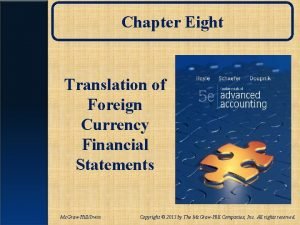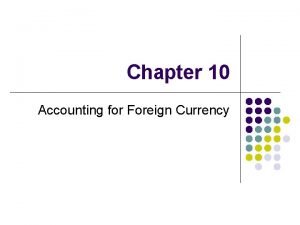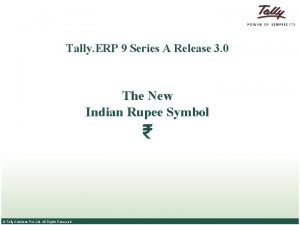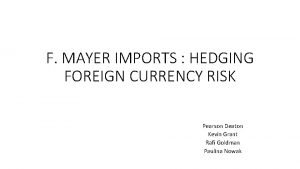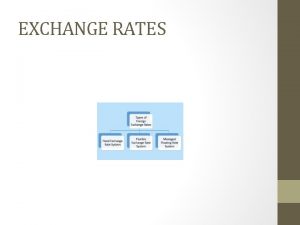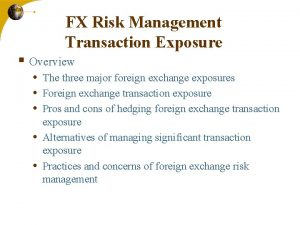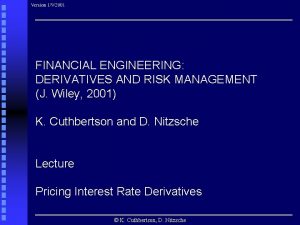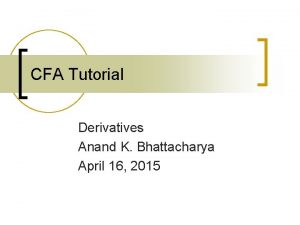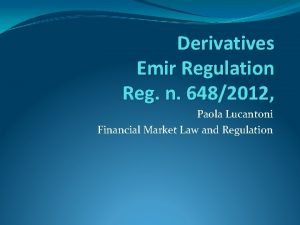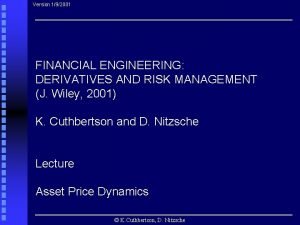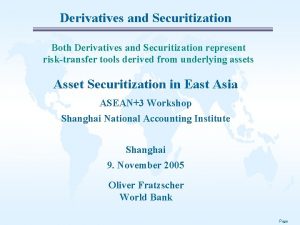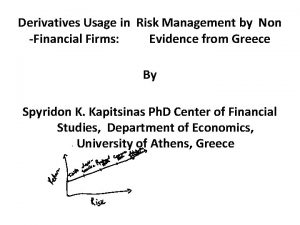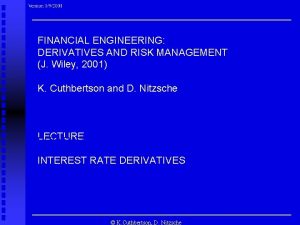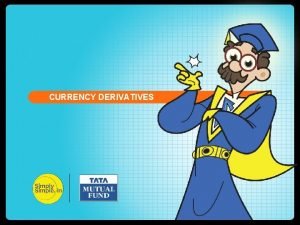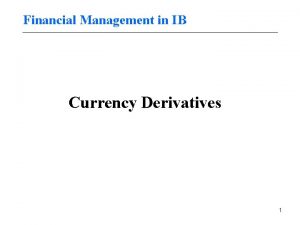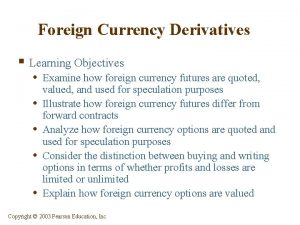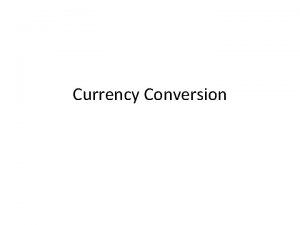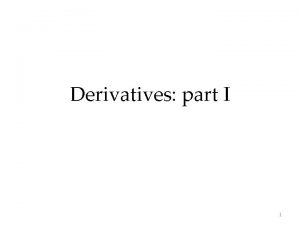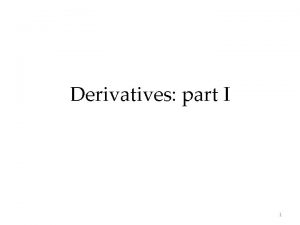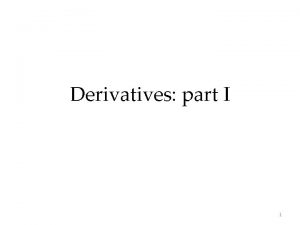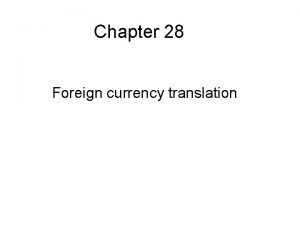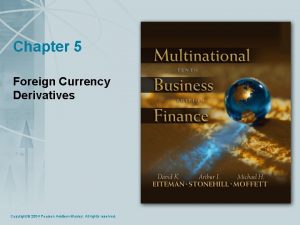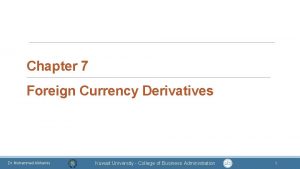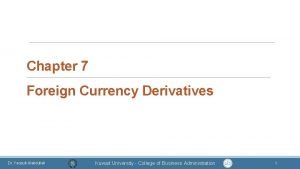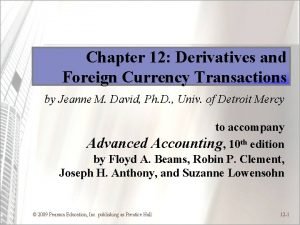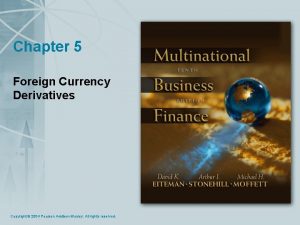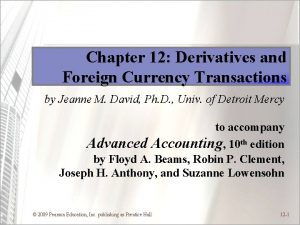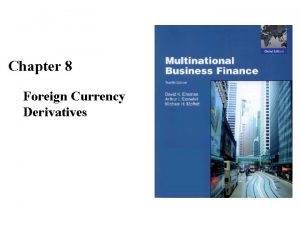Foreign currency derivatives What are the financial derivatives





















- Slides: 21

Foreign currency derivatives

What are the financial derivatives? • Financial instruments whose values are derived from the value of an underlying asset. • Are used to fulfill two different management objectives: speculation and hedging. Speculation: if the financial manager of a company purchase it in order to take positions in expectation of profit. Hedging: if the financial manager of a company purchase it in order to reduce the risks associated with the everyday management of corporate cash flow.

The benefits of derivatives • Permit firms to achieve payoffs that they would not be able to achieve without derivatives, or could achieve only at greater cost. • Hedge risks that otherwise would not be possible to hedge. • Make underlying markets more efficient. • Reduce volatility of stock returns. • Minimize earnings volatility. • Reduce tax liabilities. • Motivate management.

Definitions: Spot, Forward, Futures Contracts • The spot contract is an agreement to buy or to sell an asset today. • The forward contract is an agreement to buy or to sell an asset at a certain future time for a certain price. • The futures contract is an standardized agreement to buy or to sell an asset at a certain time in the futures at a certain price.

The position which can be taken by derivatives traders • Long position – is the position adopted by the part who agreed to buy the underlying asset on a specified future date for a certain specified price. • Short position - is the position adopted by the part who agreed to sell the underlying asset on a specified future date for a certain specified price.

Payoffs from forward contracts • Long position • Short position where: ST - F F – ST ST – the spot price of the underlying asset at forward contract maturity (T); F – the delivery price that is the forward price at which the parts agreed to buy / sell the underlying asset. The payoff can be positive or negative for the trader depending on the evolution of the spot prices in the market. Because it cost nothing to enter into a forward contract, the payoff from the contract is also the trader’s total gain or loss from the contract.

Spot and forward quotes for GBP/USD on 21. 10. 2008 Spot 1 -month forward 3 -month forward 6 -month forward Bid 1. 6399 1. 6366 1. 6309 1. 6219 Ask 1. 6403 1. 6370 1. 6313 1. 6223

Hedging through forward contracts Treasurer of a US company case • On t, the treasurer knows that the corporation will pay 1 mil. GBP in T = t + 6 months: – He must buy 1 mil. GBP – Spot price St= 1. 6403 USD/GBP – 6 month forward price 1. 6223 USD/GBP Solutions: 1. To buy spot on t 2. To buy spot on T 3. Buying forward on t for delivery on T

RESULTS • IF in T spot exchange rate rose at 1. 7 USD/GBP – Result> profit for treasurer 1. 7 USD/GBP – 1. 6223 USD/GBP = 0. 0777 USD/GBP • If in T spot exchange rate fell to 1. 55 USD/GBP – Result> loss for treasurer 1. 6223 USD/GBP – 1. 55 USD/GBP = 0. 0723 USD/GBP

Using forwards for speculation • Speculator owning 8111500 USD expects that the exchange rate GBP/USD rose up in the next 6 month. • Decision on t: buy forward GBP 1. 6223 USD/GBP, that means 500000 GBP • In T spot price is 1. 7 USD/GBP at ØReceives 5000000 GBP which is equivalent with 8500000 USD ØResult > profit 388500 USD

Foreign currency futures • Is a contract that calls for future delivery of a standard amount of foreign exchange at a fix time, place and price.

The specifications of a futures contract » Underlying asset » The contract size » Delivery arrangements » Delivery month » Price quotes » The tick size » Price limits » Position limits

The specifications of a futures contract • The underlying asset – it must be well defined, unambiguous. • The contract size – specifies the amount of the asset that has to be delivered under one contract. In some cases exchanges have introduced “mini” contracts to attract the small investors. Size of the contract is called “the notional principal ” • Method of stating exchange rates: usually are used American terms. • Delivery arrangement – it refers at the grade of asset that will be delivered and the delivery location if in the contract are specified alternatives. • Delivery months – the precise period during the months when the delivery can be made. The exchange also specifies: • when trading in a particular month’s contract will begin, • the last day on which trading can take place for a given contract.

• Price quotes are realized in a way that is convenient and easy to understand. • Tick size – the minimum price movement that can occur in trading. Is consistent with the way in which the price is quoted. • Daily price limits - are specified by the exchange. The exchange establish a limit up and a limit down. They are settled to prevent large price movements from occurring because of speculative excesses. • Position limits – the maximum number of contracts that a speculator may hold. The purpose is to prevent speculators from exercising undue influence on the market. • Last trading day – contracts may be traded through the second business day prior the Wednesday on which they mature. So, unless holidays interfere, the last trading day is the Monday preceding the maturity date. • Settlement – physical delivery of foreign exchange between buyer and seller – Offset position (round turn)

The margins • Initial margin – the amount that must be deposited at the time the contract is entered into. • Maintenance margin – the amount from the initial margin which have to maintained all time in the margin account • Margin call – if the amount in the margin account fall under the level of maintenance margin the investor receives a margin call and he has to top up the margin account to the initial margin level next day. • Marking to market – at the end of each trading day, the margin account is adjusted to reflect the investor’s gain or loss. • The margin requirements are the same on short and long futures position.

The Clearinghouse • The exchange Clearinghouse is an adjunct of the exchange and acts as an intermediary in futures transactions. • The main task – to keep track of all the transactions that take place during the day, so that it can calculate the net position of each of its member. • The members of the clearinghouse are required to maintain a margin account with the clearing house – the clearing margin. • There is an original (initial) margin but no maintenance margin. • The brokers who are not clearinghouse member must maintain a margin account with a clearinghouse member. • To determine clearing margins the clearinghouse calculate the number of contracts outstanding on gross or net basis.

Determination of clearing margin • The gross basis = total of long positions entered into by the clients + total short positions entered by the clients • The net basis – allows long and short positions to be offset against each other • Ex. A clearinghouse member has two clients: one with a long position in 35 contracts and another with short position in 25 contracts. – Gross margining: The clearing margin would have as basis 35+25=60 contracts – Net margining: The clearing margin would have as basis 35 -25=10 contracts

Delivery Physical delivery • Very few futures contracts lead to delivery of the underlying asset. • The decision to deliver the underlying asset is made by the party with short position. • The broker of the investor with short position issues a notice of intention to deliver to the exchange clearinghouse. • The exchange choose a party with a long position to accept delivery. Usually is choused the party with the oldest outstanding long position. • The critical days: – The first (last) notice day – is the first (last) day on which a notice of intention to make delivery can be submitted to the exchange. – The last trading day – is generally a few days before the last notice day. • For financial futures delivery is made by wire transfer.

Delivery Cash Settlement • Is used because: – is inconvenient the delivery of the underlying asset; – is impossible the delivery of the underlying asset. • When a contract is settled in cash, all outstanding contracts are declared closed on a particular day. • The final settlement price is set equal to the spot price of the underlying asset at either the opening or close of trading on that day.

Newspaper quotes • OPEN – the price at which contracts were trading immediately after the opening bell. • HIGH – the highest price achieved during the day. • LOW – the lowest price achieved during the day. • SETTLE (settlement price) – the price used for calculating the daily gains and losses. Is usually the price at which the contract is traded immediately before the bell signaling the end of the trading day. • CHG (change) – the change in the settlement price from the previous day. • LIFETIME (HIGH, LOW) – the highest and the lowest price achieved by that futures contract over his lifetime. • OPEN INTEREST – the total number of contracts outstanding. • VOLUME TRADING – show the estimated volume of trading in contracts of all maturities and the actual volume of trading in these contracts.

Using foreign currency futures contracts Short position • If the trader believes that the price of the underlying asset will fall down he will sell the futures contract. So he locks in the right to sell the underlying asset at the price set in the moment when he sold the contract (settled price). Long position • If the trader believes that the price of the underlying asset will rise up he will buy the futures contract. So he locks in the right to buy the underlying asset at the price set in the moment when he sold the contract (settled price).
 Insidan region jh
Insidan region jh Financial statements translation
Financial statements translation Fx accounting
Fx accounting Rupee symbol in tally
Rupee symbol in tally F. mayer imports: hedging foreign currency risk
F. mayer imports: hedging foreign currency risk Exchnage rates
Exchnage rates Currency derivatives
Currency derivatives Here you are too foreign for home
Here you are too foreign for home Types of exchange rate
Types of exchange rate Financial engineering derivatives and risk management
Financial engineering derivatives and risk management St x
St x Paola lucantoni
Paola lucantoni Financial engineering derivatives and risk management
Financial engineering derivatives and risk management Securitization
Securitization Non financial derivatives
Non financial derivatives Financial engineering derivatives and risk management
Financial engineering derivatives and risk management Vẽ hình chiếu vuông góc của vật thể sau
Vẽ hình chiếu vuông góc của vật thể sau Công thức tính thế năng
Công thức tính thế năng Tỉ lệ cơ thể trẻ em
Tỉ lệ cơ thể trẻ em Thế nào là mạng điện lắp đặt kiểu nổi
Thế nào là mạng điện lắp đặt kiểu nổi Lời thề hippocrates
Lời thề hippocrates Vẽ hình chiếu đứng bằng cạnh của vật thể
Vẽ hình chiếu đứng bằng cạnh của vật thể

